Tarot Decks and Tarot Cards with Printed Keywords
When you start studying the Tarot, you will find many decks that will catch your eye. Some of these decks might have keywords printed on the cards. Typically, Thoth-based Tarot Card Decks always had keywords printed on the card image. However, the decks I am worried about aren’t those decks.
Essentially, we have two types of Tarot Decks with printed keywords: those with a single keyword and those with multiple keywords.
Tarot Cards with Printed Keywords: Thoth-Based Tarot Decks
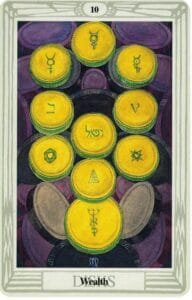 The idea of Tarot Cards with printed keywords is not a new one. It can be traced back to decks like the Thoth tarot, where cards have a single keyword printed on the image.
The idea of Tarot Cards with printed keywords is not a new one. It can be traced back to decks like the Thoth tarot, where cards have a single keyword printed on the image.
Thoth-based decks have keywords printed on the bottom of the card image. Other Thoth-based decks like the Tarot of the Spirit and the Rosetta Tarot also have keywords printed on them. All these keywords are usually in keeping with the card’s interpretation system and often indicate the big energy at play within the card image.
Tarot Cards with Printed Keywords: Non-Thoth Tarot Decks
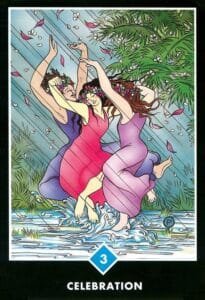 Many decks, such as the Next World Tarot and the Osho Zen Tarot, also include keywords on their cards. These keywords differ from traditional Thoth Tarot keywords and often follow the themes set by their individual Deck Creators. Some of these keywords summarize the card’s meaning and interpretation.
Many decks, such as the Next World Tarot and the Osho Zen Tarot, also include keywords on their cards. These keywords differ from traditional Thoth Tarot keywords and often follow the themes set by their individual Deck Creators. Some of these keywords summarize the card’s meaning and interpretation.
I find the presence of this single keyword distracting, and I have trained myself not to look at the keyword when I use that deck. This has not been an easy process!
Challenges for Visual Tarot Readers: Using Tarot Cards with Single Printed Keywords
Keywords printed on the Cards may be helpful guides for beginners or aid in memorization of card information. Having several keywords printed on the card image does create challenges, especially for visual readers. In some decks with multiple keywords, I’ve noticed that the card image size has been reduced to make space for these keywords! These are the decks that I have a genuine problem with.
While reading with the single-keyword decks, I often get distracted by the Keyword on the card face. As a visual Tarot Reader, I rely on the image to inspire and connect me to the intuitive insights that come through. So when I read with single-keyword decks, my eyes automatically get drawn to the keyword printed on the image. This distracts from what my intuition is trying to tell me. The keyword starts echoing in my head, and the other intuitive information gets drowned out in that noise.
If this is what happens with a single keyword printed on the bottom of the Tarot Card image, you can only imagine how chaotic it gets with multiple keywords printed on the card!
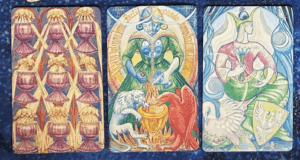 In the past, the only way I’ve been able to work with the decks with a single keyword or keyphrase on the card image is by training myself not to look at that part of the card until I’ve heard what my intuition has to say. This is not an easy habit to build, especially because I look at the card image at a glance during the reading.
In the past, the only way I’ve been able to work with the decks with a single keyword or keyphrase on the card image is by training myself not to look at that part of the card until I’ve heard what my intuition has to say. This is not an easy habit to build, especially because I look at the card image at a glance during the reading.
Recently, I became a bit brave and got the card edges cut off, effectively removing the keywords in the process. I have done this with all my Thoth decks. What a positive change this has done for my readings!
I can always recall the printed keywords if I need to. However, they are now grouped with the other keywords for that particular card. Thus, they don’t interfere with my visual intuitive-creative Reading process.
The Pitfalls of Multiple Keywords Printed on Tarot Cards
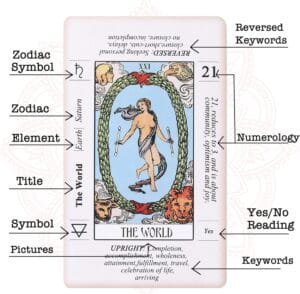 The emergence of Tarot decks with Tarot Cards with multiple keywords printed on them has created some very pressing concerns.
The emergence of Tarot decks with Tarot Cards with multiple keywords printed on them has created some very pressing concerns.
One positive use of these decks could be assisting with memorizing the card keywords. You could use these cards like you would use Flash Cards to memorize useful data/information about the card.
Any more than that, and students run the risk that these cards become crutches that impede their intuitive reading process. Relying too heavily on keywords may hinder the intuitive process of interpreting the cards based on imagery and personal intuition.
This over-reliance on keywords can limit creativity and restrict the reader’s ability to intuitively connect with the deeper meanings of the cards.
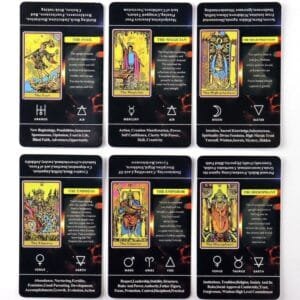 Focusing solely on the printed keywords could also lead the readers to overlook the rich symbolism and imagery of the cards, missing out on the profound insights these imagery components can offer. This could prevent the Tarot student from adding to their knowledge of the card’s esoteric meanings.
Focusing solely on the printed keywords could also lead the readers to overlook the rich symbolism and imagery of the cards, missing out on the profound insights these imagery components can offer. This could prevent the Tarot student from adding to their knowledge of the card’s esoteric meanings.
I’ve also observed a few students who used these decks with multiple keywords printed on them. Over time, they start relying on those keywords for interpretations — and rarely look at the card image to guide and inspire their interpretations. What’s worse is that when they work with a regular deck, they find themselves stuck and unable to make sense of the card!
In my opinion, learning with such decks can hinder the process of intuitive interpretation. I would caution Tarot Beginners about using such Tarot Card Decks while learning.
Embracing Intuition and Imagery
The essence of a good Tarot Reading lies in connecting with the card imagery and interpreting it in the context of the question. The card imagery components guide a Tarot Reader to an intuitive interpretation. These images inspire creative interpretations that infuse the Reading story with an engaging narrative that helps contextualize the Reading for the querent.
It is the card images that inspire intuition, imagination, and interpretation.
Readers can unlock the true potential of the Tarot Cards by immersing themselves in the visual cues of the cards and by tapping into their intuition. Readings can feel like magic when you embrace the visual symbolism of the cards and allow the free flow of intuition and creativity.
When a Tarot student learns how to read the Cards by looking at the card image and using their common-sense interpretations, they also learn how to connect with their intuition. This process happens quite unknowingly, very subtly.
However, when you start reading keywords printed on the cards, you engage your intellect in the interpretation process. You completely sideline the intuitive and creative processes.
Learning to read the Tarot with these multiple-keyword cards can hamper your intuitive and creative journey! To me, that is quite a serious matter. After all, isn’t the Tarot one of the most amazing ways of connecting with your intuition and creativity?
Honestly, if the keywords were all that mattered, why do the Tarot cards even have pictures on them? Should we print cards with keywords on them and no images? Will they also inspire intuition and creativity like the Tarot Card images do?
Keywords emerge from our interpretations of the card’s image. Those images are interpreted subjectively. While basic card meanings may remain what they are, the interpretations of the card imagery change from reading to reading, context to context. This applies to the Tarot de Marseilles cards as well — those pictures also have a lot going on which helps the intuitive interpretation process.
Keywords are a great way to memorize the card’s meaning and get unstuck while Reading. However, their presence on the card image can be an awful distraction that creates hurdles in the Reading process. Keywords do have their place as learning tools. However, they should not overshadow the importance of the image-based intuitive insights that spark creative interpretations while doing Tarot Readings. Tarot Readers and Tarot Students should cultivate a connection with the card imagery to spark their intuitive insights and interpretations.
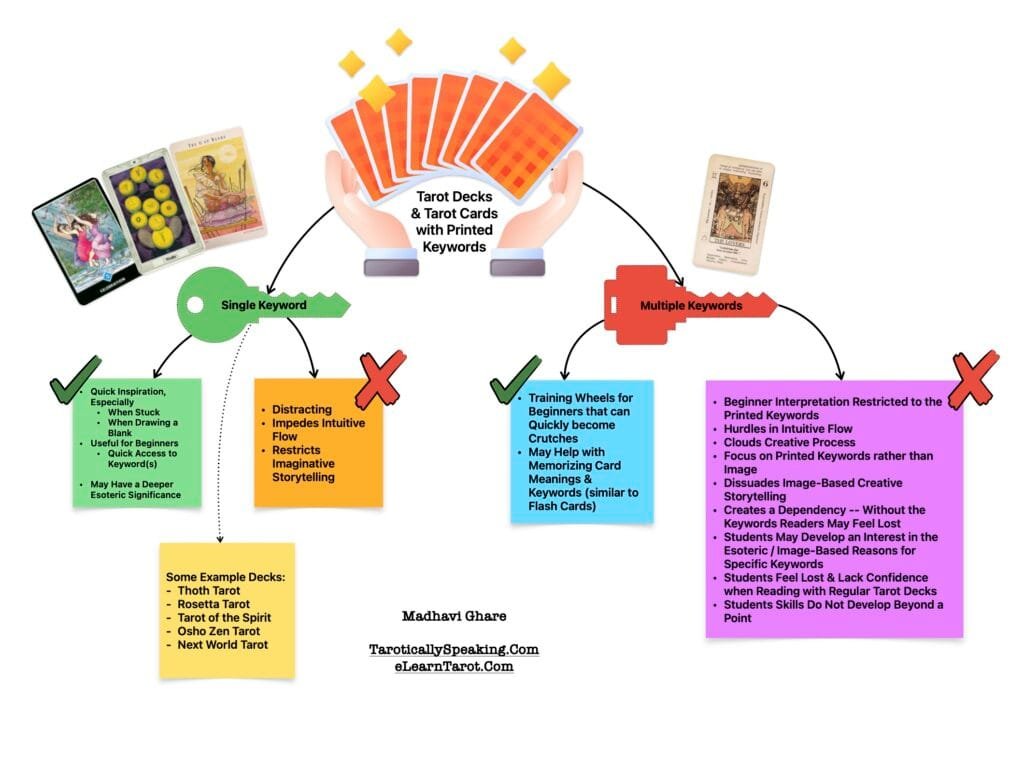
Ultimately, the Tarot is about letting the pictures speak to you and trusting your intuitive abilities to guide you.
I would sincerely like to tell Tarot Students: Please don’t start your Tarot learning journey by learning to depend on these printed keywords. Instead, learn how to interpret the card image, and awaken your intuitive and creative potential. The Tarot card images are a vast storehouse of wisdom. Working with the card images will guide you to discover many gems of insight hidden within these colorful pictures.
When you learn the simple, easy, and most natural way to create keywords based on card images — you won’t need to memorize long lists of card meanings, ever!
What Do You Think?
Do you have a different experience working with Tarot Decks and Tarot Cards with Printed Keywords? Do you like having single or multiple keywords printed on your cards? What makes this a preferred option for you?Alternatively, have you struggled with moving past your dependency on such decks? How did you overcome this dependency? What tips, tricks, or methods did you use to stop using these decks with multiple keywords?Do share your experiences, thoughts, ideas, and insights with me. I would love to hear your take on these Tarot Decks and Tarot Cards with Printed Keywords!

